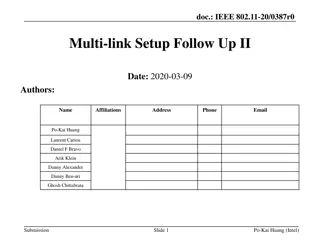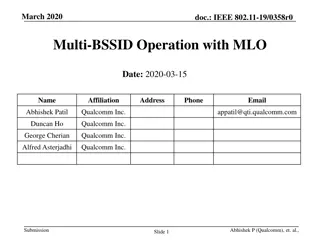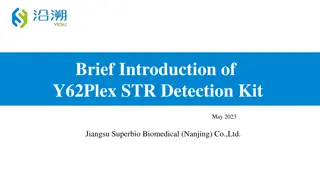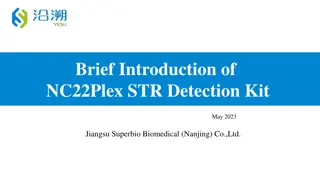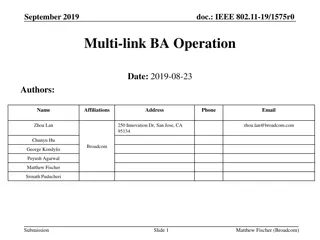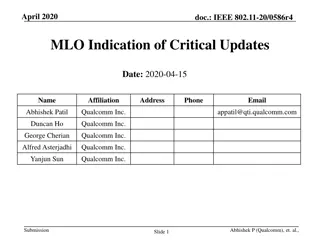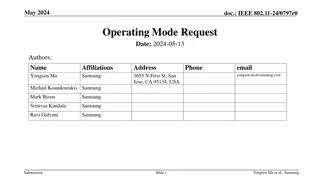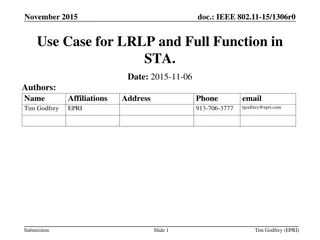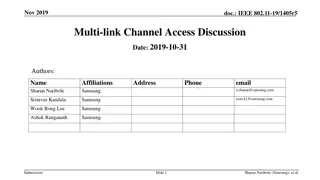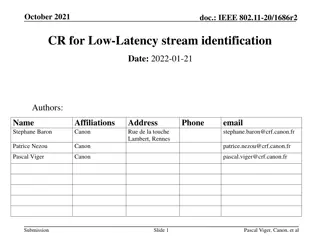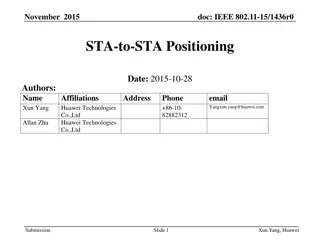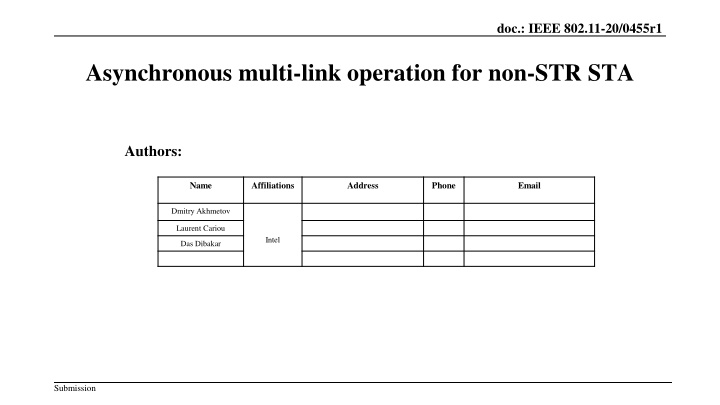
IEEE 802.11-20/0455r1: Asynchronous Multi-Link Operation for Non-STR STA
Explore the proposed asynchronous multi-link operation focusing on non-STR STA in IEEE 802.11-20/0455r1. Discusses benefits, limitations, and considerations for efficient channel access and performance enhancements in DL/UL scenarios.
Uploaded on | 2 Views
Download Presentation

Please find below an Image/Link to download the presentation.
The content on the website is provided AS IS for your information and personal use only. It may not be sold, licensed, or shared on other websites without obtaining consent from the author. If you encounter any issues during the download, it is possible that the publisher has removed the file from their server.
You are allowed to download the files provided on this website for personal or commercial use, subject to the condition that they are used lawfully. All files are the property of their respective owners.
The content on the website is provided AS IS for your information and personal use only. It may not be sold, licensed, or shared on other websites without obtaining consent from the author.
E N D
Presentation Transcript
doc.: IEEE 802.11-20/0455r1 Asynchronous multi-link operation for non-STR STA Authors: Name Affiliations Address Phone Email Dmitry Akhmetov Laurent Cariou Intel Das Dibakar Submission
doc.: IEEE 802.11-20/0455r1 Recap [1, 2]: In [1] we proposed classification of multi-link device operations based on channel access capabilities SPC single primary channel operation; ~1.27x gain over single link MPC multiple primary channel operation; ~2.09x gain over single link; preferable as it reuse existing channel access mechanism JMPC join multiple primary channel operation; ~ 2.2x gain over single link In [2] we discussed limitations raising from radio coexistence issues of co-located radios isolated (R)estricted MPC operation; ~1.9x gain over single link for DL case non-isolated (R)estricted MPC operation; ~1.6x gain over single link DL case MPC/Async mode still provide decent performance in terms of throughput for DL case while keeping ETE benefits for UL case Based on [1] and [2] we conclude that in terms of Channel Access (or TXOP initiation) an asynchronous mode of operation a.k.a. Multiple Primary Channels mode (MPC) is preferable Submission 2
doc.: IEEE 802.11-20/0455r1 Recap [3, 4, 5]: We focus on non-STR STA / STR AP case We presented simulation results on Async performance in DL-only direction with the analysis of impact of non-STR STA response (BA on link1 ) to the RX process on link 2 Corner case: 1 MLD AP + 1 MLD STA of ~1.5x 1.8x vs single link Generic case: 1 AP + multiple STAs ~1.9x gain in case of partial AMPDU losses ~1.5x 1.8x gain in case of lost the end of AMPDU A several ideas on PPDU end alignment were discussed to solve/improve beforementioned problem In [5] stated that DL-only is a rare use case and mix DL/UL mode need to be considered In mix mode for isolated 1 AP and 1 STA best performance achieved with sync (JMPC) access Synchronization is required to avoid staggering; otherwise UL throughput is destroyed PPDU alignment is claimed as a possible solution to the staggering problem backoff DL PPDU AP 1 STA 1 BA STR AP MLD Non-STA STA MLD backoff DL PPDU lost AP 1 STA 2 BA Submission 3
doc.: IEEE 802.11-20/0455r1 Lowlight/downsides/bright sides of Sync/JMPC access What is it: Sync, one primary channel and a secondary channel 80+80 type of operation already exist in a spec Contend on a dedicated primary channel/link, access to the medium on a secondary\other\second link by doing ED for PIFS time JMPC, multiple primary channels with join contention Newmode that has to be defined in a spec All links contend for medium, access to the medium on another link a by doing ED for PIFS time Why it is attractive Allow easy link aggregation in both DL and UL Seems to be a solution for non-STR operation synchronous access which naturally align TX/TX and RX/RX operations Why it is not attractive Regulatory restriction\prohibition on access to a medium with PIFS access Limited applicability Synchronous access only works in clean environment (no OBSS/legacy/hidden nodes around) JMPC is independent of environment but chances of join medium access are not high JMPC has fairness issues If implemented for Multi-Link operations may provide a door for channel access abuse Submission 4
doc.: IEEE 802.11-20/0455r1 Notes on DL and UL traffic coexistence DL traffic : DL traffic prevail in a network, so addressing DL aggregation would be logically the first thing to do we assume AP MLD side does not suffer from leakages so DL might be easier to handle Simulation results shows that in DL only case w/o applying any special techniques we get decent performance UL traffic is important, but much smaller comparing to DL traffic non-STR device is self aware about constraints and in most cases will be self-synchronized between links TX on one link stop/pause the other link so device is naturally should does not hurt much self RX operations So, separately DL and UL traffic are not a concern to each other in a communication between STR AP and non-STR STA Submission 5
doc.: IEEE 802.11-20/0455r1 Device capabilities are important to consider There were a lot of contributions and discussions mentioning device quality/integration Level of integration matters an MDL STA may or may not have capability to exchange information between instances in a timely manner Amount of shared information may vary greatly can signal only CCA status of a link Or can provide full MAC/PHY state (i.e. transmit address, current TX duration, TX data or expect response, etc) Or cannot share anything Four possible corner cases considered in a following simulations iAP or iSTA integrated AP/STA. An AP/STA that can share full internal MAC/PHY state within MLD device For example: a non-STR STA want to start a TXOP on link1, it may request link 2 status and transmit if link 2 PHY status is IDLE and MAC status is Backoff OR may not transmit if link 2 PHY status is IDLE but MAC status is Expecting Ack For example: an STR AP may to transmit on link 1 to non-STR STA1 if link 2 is receiving from STR STA2; OR it may not to transmit if MAC status on link2 is sending CTS to non-STR STA1 ; OR transmit to non-STR STA1 if MAC status of link 2 Sending data to non-STR 1 nAP or nSTA non-integrated AP/STA. An AP/STA that has no sharing/communication capabilities Note: in case of non-STR device (i.e. device with leakage) we assume involuntary information sharing through CCA signals raised due to interference Note: an AP in such case cannot verify if it is talking to a non-STR device on another link Submission 6
doc.: IEEE 802.11-20/0455r1 Simulation assumptions Simplest case, 1 MLD AP, 1 MLD STA Two links, 1x1x80 @ MCS11 RTS/CTS on Symmetrical saturated DL and UL traffic on each link of 600mbps in both directions Results averaged over 10 simulation runs, 10 seconds each iSTA/iAP behavior: Before starting TXOP on link 1 integrated device will check status of link 2 AP/STA plan their TXOP with respect to PHY and MAC status of another link nSTA/nAP behavior Devices are not aware about presence of link/status of the other link Submission 7
doc.: IEEE 802.11-20/0455r1 JMPC vs Async JMPC (sync) obviously perform well for isolated 1 Ap 1 STA use case If both STA and AP are single-chip/tightly integrated/coordinated Does not work if one side cannot do PIFS access to sync channel results IF AP has bad integration there in NO possibility for UL traffic aggregation Async access as is , i.e. the do nothing provide some UL, i.e. see no staggering problem Submission 8
doc.: IEEE 802.11-20/0455r1 Do something (PPDU alignment) In [3, 4, 5] we mentioned few way to achieve PPDU end alignment to avoid self interference (for DL aggregation), fight staggering and enable synchronization (for DL and UL aggregation) Option 1: Within device signaling assuming this signaling is possible Option 2: Over the air signaling in CTS frame Option 3: Artificial PPDU alignment to some slot boundaries known to AP MLD instances Option 4: Clever use of delayed BA We consider Option 1 for iAP/nSTA and iAP/iSTA cases and Option 2 for nAP/iSTA case Preferred\simple Submission 9
doc.: IEEE 802.11-20/0455r1 DL/UL mix with PPDU alignment improve UL traffic for completely integrated case, a more balanced traffic pattern enable nAP/iSTA case Can we do better and enable all cases? Submission 10
doc.: IEEE 802.11-20/0455r1 What seems more important for constrained devices: Is to have a separation of DL and UL traffic in time To avoid uncontrolled DL/UL but to have only UL or DL over a period of time, As we have shown before DL case perform well for SRT AP non-STR STA communication In turn, UL is self-controlled at non-STR STA (one link block the other preventing a mix of ops) It is a general understanding that STA, unlike AP, will have better/tighter link integration/interaction, so quick state signaling or operation management is possible A separation of DL and UL traffic would highly likely solve UL/DL mix use case where TX operation from a non-STR STA may interfere with TX operations of STR AP and vice versa Traffic separation is a natural solution to enable all/most possible combinations of AP/STA levels of integration Submission 11
doc.: IEEE 802.11-20/0455r1 Per link DL \ UL traffic separation Few possible options to organize that: TWT negotiation to say only DL/Triggered UL or only EDCA based UL during the SP Or a signaling so that STA controls when DL can start or not , e.g., STA stays in DL Rx unavailable state in both links during EDCA based UL transmission so that AP does not transmit DL frames during that state STA comes out of that state to be able to receive DL packets on both links May require changes to existing PSM signaling to cover some cases (e.g., U-APSD). Or may be have special rules to disallow certain operation on links per TXOP basis For instance, mandate RTS/CTS exchange when talk to/from non-STR device and have special rules for CTS response to indicate STA unavailability for operation on a certain link during TXOP Simulation parameters for traffic separation DL duration period : 0.1s UL duration period : 0.1s Consider in MPDU/BA signaling Submission 12
doc.: IEEE 802.11-20/0455r1 DL-Rx unavailable state The STA can signal when it is unable to receive DL frames by a one bit signaling in UL frames (incl. Data or BA frames). On reception of this frame and after Acking, the AP does not transmit any DL Data frames to this STA regardless of the power state and modes of that STA starting the end of current TXOP By default the signaling is done independently on all links. DL-Rx Available = 0 DL-Rx Available = 1 Non-AP MLD AP MLD AP 1 STA 1 Link 1 AP 2 STA 2 Link 2 time Suspend DL Data frames : Ack : UL Data : DL Data : U-APSD SP : STA in Doze Submission 13
doc.: IEEE 802.11-20/0455r1 Traffic separation vs PPDU alignment vs Do nothing Traffic separation naturally enable traffic in all 4 possible cases Submission 14
doc.: IEEE 802.11-20/0455r1 Conclusion Traffic separation enable traffic in both directions in case of DL/UL mix for all observed configurations in isolated 1 AP 1 STA case Note: in generic 1 AP/Many STAs a conflict of DL/UL traffic at non-STR STA will happen less often. PPDU end alignment enable nAP/iSTA case and improve UL throughput in iAP/iSTA case Amount of shared information/level of AP/STA integration greatly affect results and need to be explicitly considered/mentioned in behavior analysis Having asymmetrical setup, like iAP/nSTA or nAP/iSTA, harm overall system behavior JMPC work only in one case when devices have full information and able to grab medium at the same time Both parties shall be able to synchronize their start of PPDU not always possible Synchronization is an issue in a non-isolated Submission 15
doc.: IEEE 802.11-20/0455r1 Straw poll 1 Do you agree 802.11be as a part of R1 spec development focus on the following ML device configurations: STR STA MLD non-STR non-AP MLD Submission 16
doc.: IEEE 802.11-20/0455r1 Straw poll 2 Do you agree as a part of R1 spec development 802.11be when defining modes of operation with concurrent transmission on multiple links for devices with non-STR capabilities to focus on modes where STR AP MLD is the initiator of such transmission. Submission 17
doc.: IEEE 802.11-20/0455r1 Straw poll 3 Intro: DL/UL separation can be enabled/controlled today by the STA by using power management mode changes, or power state changes, or availability state change. As AP MLD will buffer DL BUs when the STA is in doze state/unavailable Do you agree to extend the conditions for which a STA can change its power states/availability states For example, during a U-APSD service period, being able to go to doze state at any time Submission 18
doc.: IEEE 802.11-20/0455r1 Straw poll 4 Do you agree that STR AP MLD shall not be constrained to align end of PPDU in a concurrent DL transmission to a non-STR non-AP MLD. The alignment procedure is implementation-specific Submission 19
doc.: IEEE 802.11-20/0455r1 References [1] 11-19-1291-03-00be-some-aspects-of-multi-link-op-performance, Intel [2] 11-19-1541-01-00be-performance-aspects-of-multi-link-op-with constraints, Intel [3] 11-20-0081-00-00be-mlo-synch-transmission, Broadcomm [4] 11-19-0106-02-00be-discussion on multi-link operation with leakage on non-AP MLD, Intel [5] 11-20-0275-00-00be-need-for-sync-ppdu, Qualcomm [6] 11-20-0026-01-00be-MLA Support for Constrained Devices, Qualcomm [7] 11-19-1928-01-00be-multi-link-operation-performance-evaluation, Mediatek Submission 20
doc.: IEEE 802.11-20/0455r1 Backup Submission 21
doc.: IEEE 802.11-20/0455r1 Risks with a sync mode We don't want to break backoff rules and allow an AP that is in synch on a channel with other contending STAs to be able to ignore backoff and just follow NAV + CCA This is different from secondary channel access, as the STA accessing secondary channel is not in synch with the other contending STAs (does not know when the CP occurs). The other link is an independent link with independent channel access aligned with other devices operating on that link There are regulatory restrictions to do PIFS access on independent channel/link Risks of unfairness if we go full-sync direction: A sync AP MLD with an AP1 alone on link 1 and with an AP2 sharing medium with other AP(s) on link2. If that AP1 carefully chooses TxOP duration on link 1 to always end (Backoff time) before TxOP on link2, so that AP1 ends backoff right at the start of the CP on link 2: this way, link2 is always gained by the AP2. Basically if we allow this mode, there is a clear potential abuse. CP CP TxOP1 TxOP1 Backoff Backoff P I F S P I F S TxOP2 TxOP2 Submission 22

